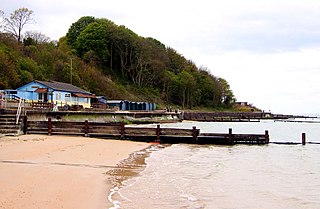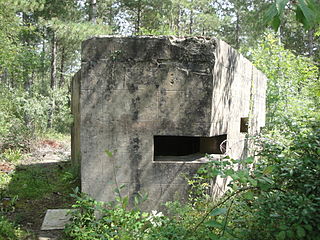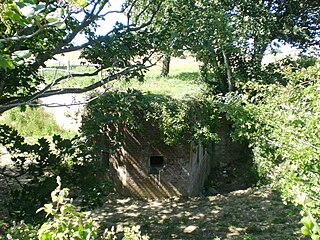
The Needles are a row of three stacks of chalk that rise about 30 metres (98 ft) out of the sea off the western extremity of the Isle of Wight in the English Channel, United Kingdom, close to Alum Bay and Scratchell's Bay, and part of Totland, the westernmost civil parish of the Isle of Wight. The Needles Lighthouse stands at the outer, western end of the formation. Built in 1859, it has been automated since 1994. The waters and adjoining seabed form part of the Needles Marine Conservation Zone and the Needles along with the shore and heath above are part of the Headon Warren and West High Down Site of Special Scientific Interest.

Hurst Castle is an artillery fort established by Henry VIII on the Hurst Spit in Hampshire, England, between 1541 and 1544. It formed part of the king's Device Forts coastal protection programme against invasion from France and the Holy Roman Empire, and defended the western entrance to the Solent waterway. The early castle had a central keep and three bastions, and in 1547 was equipped with 26 guns. It was expensive to operate due to its size, but it formed one of the most powerful forts along the coast. During the English Civil War of the 1640s, Hurst was held by Parliament and was used briefly to detain King Charles I before his execution in 1649. It continued in use during the 18th century but fell into disrepair, the spit being frequented by smugglers.

Fort Albert is a tower fort nestling under the cliffs south-west of Fort Victoria on the Isle of Wight, England. It was also known as Cliff End Fort, named after the Northern extremity of Colwell Bay.
Grain Fort is a former artillery fort located just east of the village of Grain, Kent. It was constructed in the 1860s to defend the confluence of the Rivers Medway and Thames during a period of tension with France. The fort's location enabled its guns to support the nearby Grain Tower and Garrison Point Fort at Sheerness on the other side of the Medway. It was repeatedly altered and its guns upgraded at various points in its history, before being decommissioned in 1956 when the UK abolished its coastal defence programme. It was subsequently demolished. The remnants of the fort are still visible and have been incorporated into a coastal park.

The Royal Commission on the Defence of the United Kingdom was a committee formed in 1859 to enquire into the ability of the United Kingdom to defend itself against an attempted invasion by a foreign power, and to advise the British Government on the remedial action required. The appointment of the Commission had been prompted by public concern about the growing military and naval power of the French Empire and was instigated by the Prime Minister, Henry Temple, 3rd Viscount Palmerston, who came to be closely associated with the project. In the following year, the Commission's report recommended a huge programme of fortification to defend the country's arsenals and naval bases. Many of the recommendations were acted upon; however, the great expense, the length of time taken to complete the various works and their perceived usefulness were all subjects of critical political, press and public debate.

The Needles Batteries are two military batteries built above the Needles stacks to guard the West end of the Solent. The field of fire was from approximately West South West clockwise to Northeast and they were designed to defend against enemy ships.

Warden Point Battery is a battery on the Isle of Wight begun in 1862, that was originally armed with 7-inch and 9-inch rifled muzzle loaders on barbette mountings.

Bouldnor Battery is a military battery located in Bouldnor on the Isle of Wight. It saw active service in World War II and was fully decommissioned in 1956. Today, it is a Scheduled Ancient Monument.

Yaverland Battery is a battery on the Isle of Wight, United Kingdom. It was constructed between 1861 and 1864.
The 1st Isle of Wight Rifle Volunteers, later the 8th Battalion, Hampshire Regiment, but known informally as the 'Isle of Wight Rifles', was an auxiliary unit of the British Army formed to defend the Isle of Wight after a mid-19th Century invasion scare. During World War I it fought in the Gallipoli Campaign, taking part in the calamitous attack at Suvla Bay, and later at the battles of Gaza and Megiddo in Palestine. Between the wars it was converted to coast defence artillery and served in this role on the Isle of Wight throughout World War II. One battery was sent to reinforce the garrison of Tobruk, where it was captured in 1942. Postwar the unit converted to the air defence role, then reverted to infantry, and its successors continue in today's Army Reserve.

The RML 9-inch guns Mark I – Mark VI were large rifled muzzle-loading guns of the 1860s used as primary armament on smaller British ironclad battleships and secondary armament on larger battleships, and also ashore for coast defence. It should not be confused with the RML 9-inch Armstrong Gun, used by the Dutch navy, the Spanish Navy, and other navies.

Freshwater Redoubt, also known as Fort Redoubt, is an old Palmerston fort built in Freshwater Bay on the western end of the Isle of Wight. Construction work for the fort began in 1855 and was completed in 1856. It was finally sold in 1928 and has now been converted into a private residence.

The RML 12.5-inch guns were large rifled muzzle-loading guns designed for British battleships and were also employed for coast defence.

Puckpool Battery is a battery located at Puckpool Point, close to the town of Ryde on the Isle of Wight. It is one of the many Palmerston Forts built on the island to protect it in response to a perceived French invasion. Construction of the battery began in 1863 and was completed by March 1865.

Nodes Point Battery is a battery located at Nodes Point on the Isle of Wight. It is one of the many Palmerston Forts built on the island to protect it in response to a perceived French invasion. Construction of the battery began on 16 August 1901 and was completed by 20 April 1904.

Cliff End Battery is a battery on the west coast of the Isle of Wight overlooking Fort Albert. It is one of the many Palmerston Forts built on the island to protect it in response to a perceived French invasion. Construction of the battery began in 1862 and was completed by 1868 at a cost of £32,714.

The 68-pounder cannon was an artillery piece designed and used by the British Armed Forces in the mid-19th century. The cannon was a smoothbore muzzle-loading gun manufactured in several weights, the most common being 95 long cwt (4,800 kg), and fired projectiles of 68 lb (31 kg). Colonel William Dundas designed the 112 cwt version in 1841 and it was cast the following year. The most common variant, weighing 95 cwt, dates from 1846. It entered service with the Royal Artillery and the Royal Navy and saw active service with both arms during the Crimean War. Over 2,000 were made and it gained a reputation as the finest smoothbore cannon ever made.
Many forts and fortifications have been built to protect the Isle of Wight from foreign invasion. Throughout history the island has been a site of key military importance. Controlling both entrances to the Solent and the home of the Royal Navy, Portsmouth. This is a list of most of the fortifications on the island.

Dummy Battery, originally known as Grain Battery, is a disused fortified gun battery located about 1 kilometre (0.62 mi) south of the village of Grain, Kent at the confluence of the Rivers Thames and Medway. Completed in 1865, it supported two nearby coast artillery batteries at Grain Fort and Grain Wing Battery, a short distance to the north. The battery's arc of fire overlapped with Grain Tower just offshore and with Garrison Point Fort on the Isle of Sheppey across the other side of the Medway. It consisted of an earthwork with a concrete core supporting several gun emplacements with magazines below. It appears to have gone out of service as a battery by the time of the First World War, though it briefly took on a role in anti-aircraft defence. It was subsequently abandoned and was severely damaged by demolitions and the removal of its earthworks, leaving only the substantial remains of its concrete core standing today.

















